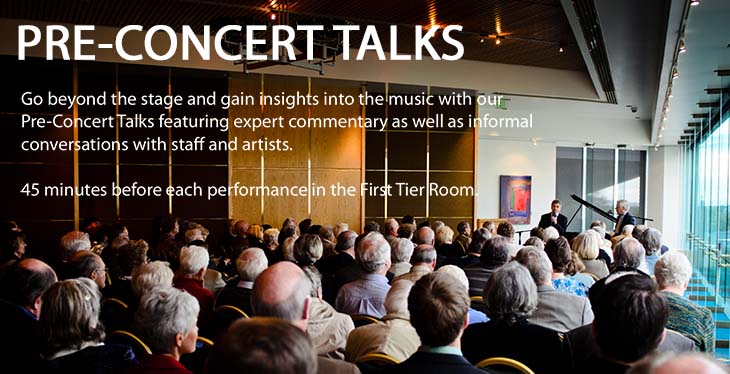Utah Symphony
History of the Music
History of the Music

By Michael Clive & Jeff Counts
Overture to Tannhäuser
WAGNER
WHAT TO LISTEN FOR: To realize his conception of opera as Gesamtkunstwerk—as a totally integrated work of art—Wagner wrote his own librettos. These were generally reinterpretations of German medieval history or myth. The holiness of pure love and its transfiguring power are recurring themes in his dramas, and they are the overriding themes in the story of Tannhäuser, which combines an actual figure from German history—a Minnesänger named Tannhäuser—with a virtuous maiden and a goddess who vie for his love against a backdrop of myth, magic, and a singing contest. Much like Wagner (who was destructively promiscuous in his personal life), Tannhäuser is a gifted troubadour but fatally attracted to the profane. The opera limns the progress of his initial downfall and his miraculous redemption.
We hear the entire course of Tannhäuser’s journey in the opera’s overture, which opens with a thrillingly sustained crescendo: a passage representing pilgrims approaching ever louder on their journey of devotion to Rome. But as their majestic chorale fades into the distance, we hear the skittering, orgiastic music of “Venusberg,” the mythic realm where Tannhäuser is lured into temptation. Tannhäuser’s story is one of sin and repentance; at its end, he, too, sings the pilgrims’ hymn, and is redeemed in death.
Das Rheingold: Introduction, Preludes and Entry of the Gods into Valhalla
Duration: 22 minutes.
THE COMPOSER – RICHARD WAGNER (1813-1883) – Before Wagner could address the music for his grand mythological tetralogy Der Ring des Nibelungen, he needed to get the story straight. According to author and biographer Charles Osborne, Wagner’s original intention in the late 1840s seems to have centered on a single opera based on the final days of the heroic Siegfried, but the composer quickly realized that more context was needed. A lot more. Working backwards from Siegfried’s death (Götterdämmerung, fourth in narrative order), Wagner sketched out libretti for Siegfried, Die Walküre and lastly, Das Rheingold. With that final (but first, actually) part of the epic tale ultimately penned in 1852, Wagner set about crafting the Rheingold music score in 1853.
THE HISTORY – When he completed the music in 1854, Wagner set Das Rheingold aside to begin work on Siegfried. He knew the Ring project was a long road, but he couldn’t have predicted the 20-plus years it would take to reach the end. Life filled the spaces in between the work, as it does, and Wagner’s family (not to mention his non-Ring composing career) expanded meaningfully over the decades. The cycle premiered at last in 1876, and Das Rheingold at that point must have felt like a half-remembered dream. It wasn’t the first time Wagner had heard it in performance, however. The composer’s patron King Ludwig II of Bavaria was instrumental in the creation of the Festival at Bayreuth and he funded the building of the first theater there. Contingent to his support was the notion that the four Ring operas would each be premiered separately. Wagner was initially in favor of the concept but soon changed his mind. The King’s mind was immovable though and in 1869, Wagner could hold him off no longer. The composer attempted to undermine the production in hopes of gaining greater control over the new theater’s staff but succeeded only in making himself a nuisance. So great, in fact, was the animosity between the composer and the project that Wagner found himself unwelcome at rehearsals. Consequently, the standalone premiere of Das Rheingold occurred on September 22 without him, seven years too early by his later reckoning. The Entry of the Gods into Valhalla at the end of Rheingold portends much about what will come in the later works of the Ring. Wotan and Loge have just concluded their mucking about in the affairs of the Earthly races, leaving greed and murder in their wake. Content with the fruitful endgame he believes he has set in motion, Wotan retires with the other gods to his celestial fortress over a rainbow bridge. Only Loge declines to join him. He knows it is the beginning of their fall.
THE WORLD – Elsewhere in 1869, War and Peace was published in book form, the Red River Rebellion set off in Canada, the Suez Canal was inaugurated, the Cutty Sark was launched in Scotland, and the “Golden Spike” was driven in Utah.
THE CONNECTION – This marks the Utah Symphony premiere of these selections from Das Rheingold.
Concerto No. 3 in D minor for Piano and Orchestra, Op. 30
Duration: 39 minutes in three movements.
THE COMPOSER – SERGEI RACHMANINOFF (1873-1943) – Rachmaninoff was, in many ways, the most reluctant of history’s great composer/pianists. Last in a line drawn from Mozart through Beethoven, Brahms and only a few others, he was heir to a demanding tradition that made him an international celebrity. Rachmaninoff introduced his brand-new Third Piano Concerto on his first American tour in 1909, a trip he had been extremely anxious about in theory and hated nearly every minute of in practice. The two New York performances were both successful but the second iteration under Gustav Mahler was the sole highlight for Rachmaninoff, who reportedly thought very highly of the Austrian maestro and his New York Philharmonic.
THE HISTORY – The Concerto was composed during a peacefully productive 1909 summer at his family estate Ivanovka. Among the other important works he produced there during contemporaneous visits were the Second Symphony, The Isle of the Dead, and the First Piano Sonata. It is interesting that this favorite creative setting would be linked through the Third Concerto with the United States, a place he did not enjoy very much. Later, in one of fate’s great ironic insults, they would be linked again by the Russian Revolution, an event that would destroy Rachmaninoff’s beloved Ivanovka and necessitate a last resort emigration to, of all places, America. The music of the piece is free of this eventual history of course and, though it took a few decades for the Third Concerto to approach the popularity of the Second, it was clear from the start that Rachmaninoff was evolving as a creative artist.
Aside from the now legendary technical challenges presented to the soloist (it was much more demanding than the Second), the structure and craft of the concerto indicate that he was asking quite a bit more of himself as a composer too. Fans of Rachmaninoff’s glorious tune-smithing need not worry though, for Concerto No. 3 includes one of his most subtly perfect. “It simply wrote itself!” he said of the generous, generative opening melody from which the piece is built. Beautiful as it was, the concerto was too difficult for any pianist but Rachmaninoff, whose own judgement on its demands could be dismissed as an early 20th century humble brag (if he were that kind of person). In his opinion, one that still must find very little support from professional pianists, the Third is “more comfortable” than the Second. Maybe for him, but it is more telling that Josef Hofmann, the work’s dedicatee, never dared to perform it. In Hofmann’s defense, few had the nerve to attempt it in those early years, until Vladimir Horowitz finally proved it possible in the 1930s.
THE WORLD – Elsewhere in 1909, the city of Tel Aviv was founded, Joan of Arc was beatified by Rome, Ernest Shackleton claimed the South Magnetic Pole, and British Petroleum had its beginnings as the Anglo-Persian Oil Company.
THE CONNECTION – Rachmaninoff’s Piano Concerto No. 3 has been performed often in Abravanel Hall, most recently in 2019 with Boris Giltburg as soloist and Carlos Miguel Prieto on the podium.
